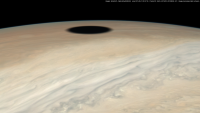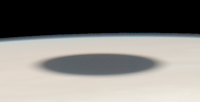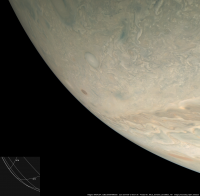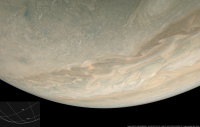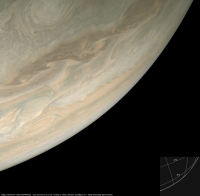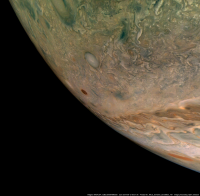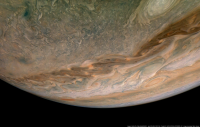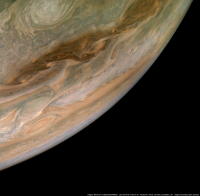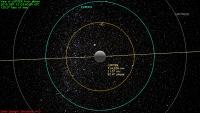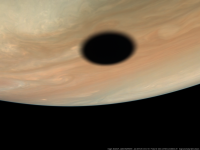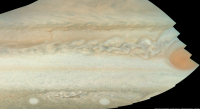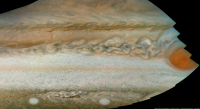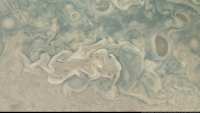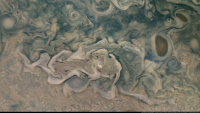Printable Version of Topic
Click here to view this topic in its original format
Unmanned Spaceflight.com _ Juno _ Juno Perijove 22
Posted by: mcaplinger Sep 13 2019, 12:37 AM
Images have started appearing on missionjuno.
Posted by: Kevin Gill Sep 13 2019, 03:55 AM
Thanks for letting us know!
First composite image using the PJ22 data
JNCE_2019255_22C00017_V01
JNCE_2019255_22C00018_V01
JNCE_2019255_22C00019_V01
JNCE_2019255_22C00020_V01
JNCE_2019255_22C00021_V01
JNCE_2019255_22C00022_V01
Reprojected to the perspective of '22.
https://flic.kr/p/2heF3Jk
https://flic.kr/p/2heF3Jk
Posted by: Kevin Gill Sep 13 2019, 11:41 PM
Shadow of Io starts appearing in PJ22-25!
https://flic.kr/p/2hf3asZ
https://flic.kr/p/2hf3asZ
Posted by: fredk Sep 14 2019, 01:13 AM
Spectacular - very cool how the projection from close up makes Io's shadow look crazy big.
Posted by: Explorer1 Sep 14 2019, 01:27 AM
Reminds me of a classic science fiction movie involving Jupiter...
Posted by: Bjorn Jonsson Sep 14 2019, 03:21 PM
Approximately true color/contrast detail from image PJ22_26 showing Io's shadow:
This image is enlarged by a factor of 2 compared to the original data. This makes Jupiter's bluish sky at the limb more obvious.
Posted by: fredk Sep 14 2019, 06:28 PM
Stunning, Bjorn. I always appreciate the attempt at true colour.
I suppose you've done some masking of the sky - the pixel values are zero in the sky, but small though nonzero in the shadow, as a gamma-tweak illustrates:
Is that just a nonzero black level in the shadow? Another idea would be real scattered illumination from the illuminated atmosphere outside the shadow, or illumination from partially sunlit moons (other than Io). Both those seem unlikely.
Posted by: fredk Sep 14 2019, 07:52 PM
A related point: knowing the geometry we should be able to plot the edge of the umbra on the image, and then measure how much scattered light is visible inside the umbra - perhaps interesting from the atmospheric science point of view?
Posted by: mcaplinger Sep 14 2019, 08:55 PM
I don't see any signal in the shadow in the raw images that is any brighter than the stray light from the instrument.
Stay tuned, the later images show the shadow even better.
Posted by: Kevin Gill Sep 14 2019, 11:58 PM
Two more composite views:
https://flic.kr/p/2hfu1ZA
https://flic.kr/p/2hfu1ZA
https://flic.kr/p/2hfn71x
https://flic.kr/p/2hfn71x
Posted by: JohnVV Sep 15 2019, 05:22 AM
https://flic.kr/p/2hf3asZ
https://flic.kr/p/2hf3asZ
for those fallowing this using Celestia , there is a spice ssc file on Celestialmatters
http://forum.celestialmatters.org/viewtopic.php?f=18&t=846&start=15#p15441
and some screen shots
http://forum.celestialmatters.org/viewtopic.php?f=18&t=846&start=15#p15437
Posted by: JRehling Sep 15 2019, 08:03 AM
I have distorted the image to circularize the shadow, and I don't see any obvious Io plumes, but then the noise of Jupiter's variation makes that a difficult search.
If there is any discernible movement of Io's shadow while ≥2 images were made of it, then it would be possible to divide an image of its penumbra by the same area of Jupiter in sunlight and search for relatively faint plume shadows.
Posted by: Bjorn Jonsson Sep 16 2019, 10:53 PM
I suppose you've done some masking of the sky - the pixel values are zero in the sky, but small though nonzero in the shadow, as a gamma-tweak illustrates:
Yes, I did some feathered masking in Photoshop near the limb. Otherwise I'd get a sharp, unrealistic cutoff in the dark (but not totally black) area a bit outside of Jupiter's limb. This is because I reprojected the raw framelets to simple cylindrical projection and added 200 km to Jupiter's radius when reprojecting to avoid losing Jupiter's sky (which usually happens if I use the cloudtop radius value).
This would be difficult because the shadow contains stray light from the instrument as pointed out in an earlier post. This scattered light varies in non-trivial fashion depending on the viewing geometry, the sun direction etc. I haven't attempted to model these effects and correct for them.
However, if memory serves there are some Galileo images where a big satellite shadow is visible. These images might have less stray light and/or be easier to calibrate if measurements of the umbra brightness are desired - I suspect compression artifacts in the Galileo images might make this impossible to measure properly though.
Posted by: Bjorn Jonsson Sep 16 2019, 11:17 PM
This is processed from image PJ22_23. Approximately true color/contrast and enhanced versions:
Posted by: JRehling Sep 17 2019, 03:05 AM
HST images might have less of a stray light issue than Juno or Galileo, and resolve the moon shadows fairly well?
https://hubblesite.org/contents/news-releases/2015/news-2015-05.html
In all cases, I guess an operational constraint in measuring the brightness inside an umbra would be image depth. If you're calibrated to show the surface of Jupiter, I would guess that the brightness in the center of a moon shadow would be far below the quantum of sensitivity. Eg, JunoCam images are returned at 8 bits, so < 1/256 is essentially zero?
FWIW, when Io, Europa, or Ganymede is casting a shadow on Jupiter, the other two of that trio must either be on the far side of Jupiter or present as a razor-thin crescent. Callisto, however, is potentially a spoiler, and a crescent/gibbous Callisto could potentially be shining onto the scene.
Posted by: fredk Sep 17 2019, 04:05 PM
Averaging over the pixels in a large-enough shadow might help. But it sounds like stray light will be the limiting factor.
About the Io-Europa-Ganymede resonance, that should be for the sidereal periods, not solar (synodic). So there's no reason you couldn't have some of those three moons fat crescent or gibbous when Io casts it's shadow on Jupiter. Here's the view during PJ22 from the https://space.jpl.nasa.gov/:
Ganymede was a fat crescent at that time.
It shouldn't be too hard to estimate the level of scattered Ganymede light at that time.
Posted by: Kevin Gill Sep 17 2019, 04:41 PM
Fisheye Composite for the Io Shadow
JNCE_2019255_22C00023_V01
JNCE_2019255_22C00024_V01
JNCE_2019255_22C00025_V01
JNCE_2019255_22C00026_V01
JNCE_2019255_22C00027_V01
JNCE_2019255_22C00028_V01
Rendered from the perspective of '28.
https://flic.kr/p/2hgQFhx
https://flic.kr/p/2hgQFhx
Posted by: Sean Sep 17 2019, 06:38 PM
Awesome results Kevin!
Posted by: JRehling Sep 18 2019, 03:14 AM
Thanks, fredk!
If the HST took a picture of Jupiter while the former was in the Earth's shadow, that would seem to limit stray light profoundly, but trying to limit noise to zero is difficult.
Posted by: Brian Swift Sep 19 2019, 04:29 AM
Animation of Io shadow eclipse progressing across Jupiter - https://youtu.be/N5A7fXWMt6k
Posted by: Bjorn Jonsson Sep 29 2019, 11:40 PM
An approximately true color/contrast version of PJ22_28 processed to give an idea of what a fairly typical consumer type camera (or even a phone) might have seen if no zoom was used:
North is to the upper left. Here Juno was very close to Jupiter's cloud tops (altitude ~7900 km) and about 12000 km from the center of Io's shadow. Because of this close range it is impossible to capture all of Jupiter's globe in a single image. For that a fisheye type lens would be needed (for a fisheye view see Kevin's image in his post earlier in the thread).
Posted by: Kevin Gill Oct 14 2019, 11:10 PM
A wide pole-to-pole map view using PJ22 imagery. Blending and alignment was done largely by hand.
https://flic.kr/p/2hv2saW
https://flic.kr/p/2hv2saW
And a flyover video on YouTube: https://youtu.be/s8smStabXqg
Posted by: Sean Oct 15 2019, 10:46 AM
This is beautiful Kevin! Amazing job!!
Posted by: Bjorn Jonsson Oct 16 2019, 12:01 AM
Perijove 22 was not a 'Great Red Spot (GRS) flyby'. Despite this, map-projected images show some details in the GRS' western half (the GRS was on the limb in a few PJ22 images). And the convective area west of the GRS was fairly well imaged during this flyby. This is a map-projected mosaic of PJ22 images 39 to 43 in approximately true color/contrast and enhanced versions:
From this it is clear that the convective area west (or WNW) of the GRS is still active. The appearance of other parts of the South Equatorial Belt (SEB) has recently at least sometimes been as if the SEB was about to fade (turn whitish) but if history is any guide, this shouldn't happen unless the convective activity west of the GRS shuts down.
It's going to be interesting to see what happens here.
Posted by: Bjorn Jonsson Nov 3 2019, 10:28 PM
This is an orthographic mosaic of images PJ22_20 and PJ22_21 in approximately true color/contrast and enhanced versions:
The small and very bright cloud below center is located near planetographic latitude 51.6 degrees north and is about 250 km across. The effects of the varying solar illumination across the image have been removed (otherwise the northern half of the image would be darker relative to the southern half than it is here).
Lots of interesting details are visible, including cloud shadows and evidence of vertical relief in the clouds. Many interesting and beautiful small ovals are also visible. Some of these appear to be connected by 'lanes'. An obvious example is the pair of brownish ovals at upper right. North is up in the images.
Posted by: mcaplinger May 6 2020, 05:21 PM
Bjorn, could you describe your workflow for getting the brightness matching to work so well from image to image for these products? I've been using a simple lambertian removal and it doesn't work very well at all, at least for the full range of geometries over the orbit.
Posted by: Bjorn Jonsson May 11 2020, 01:18 AM
These image products are several months old and involved a significant amount of work in Photoshop to reduce color and brightness seams - too much work for my taste. As a result I have made changes that greatly reduce the manual cosmetic enhancements and post-processing needed in Photoshop. What I currently do is this:
(1) Added flat fielding in December 2019. This change is probably what resulted in the biggest improvement in brightness/color matching in the overlap areas between adjacent images (not framelets). Without flat fielding the images are a bit brighter near the left/right edges relative to the center than they should be. Flat fielding also greatly reduced the seams between adjacent framelets. The flat field I'm currently using can be found http://www.unmannedspaceflight.com/index.php?showtopic=8245&view=findpost&p=246670.
(2) Use a slightly modified Lambert function, i.e. cos(i)^0.95 instead of the usual cos(i). Earlier I was using a modified Lommel-Seeliger function but the modified Lambert function works better in conjunction with (3). Areas near the terminator require special handling though since there is faint illumination on the nightside near the terminator.
(3) Multiply the result of (2) with a new/experimental limb darkening function that is a function of the emission angle. This worked almost perfectly for PJ24 and PJ25 but results are slightly worse for PJ26. It also worked rather well for making a quick-and-dirty global map of Jupiter from the G1 marble movie images. I'm now in the process of modifying the function to include the phase angle (its 'weight' must change with phase). An additional complication is that the photometric properties of the polar regions are different from areas closer to the equator. I plan on making some of the photometric parameters vary as a function of latitude. Also I'm currently using identical parameters for R/G/B in the limb darkening function but this will change.
(4) Following the previous processing steps I have several cylindrical maps that I mosaic in Photoshop and decide which one(s) has priority in overlap areas by cutting away parts of some of the mosaics in the overlap areas. This is fairly trivial and could probably be automated.
(5) Following (4) there are usually some residual color/brightness seams in overlap areas that are close to the terminator and/or limb but these are usually not big and can be easily corrected in Photoshop by modifying the brightness and color balance of one or both images near the overlap area. This processing step used to take a lot more time before the changes described in steps 1 to 3.
It should be noted that I haven't tested this for the full range of geometries but I suspect it would work well once the phase angle is taken into account in (3).
Posted by: scalbers May 11 2020, 09:01 PM
Just drawing an analogy to how I sometimes handle Earth clouds, a linear combination of the Lambert illumination with a single scattering phase function can be a good approximation. I'm continuing to work on some additional empirical BRDFs.
Powered by Invision Power Board (http://www.invisionboard.com)
© Invision Power Services (http://www.invisionpower.com)
